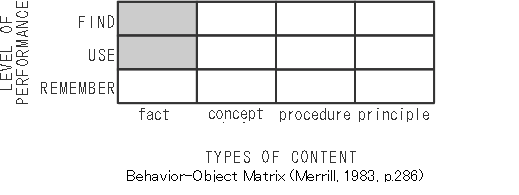|
Table of Contents for:
4.Taxonomy of Learning Objectives and Aptitude Treatment Interaction |
Your location: Home Page > (2) Theories of learning, instruction and evaluation > 4.Taxonomy of Learning Objectives and Aptitude Treatment Interaction
> Merrill's Two Dimensional Matrix and Reigeluth's Comparison Table
◆Merrill's Two Dimensional Matrix and Reigeluth's Comparison Table◆M. David Merrill classifies learning objectives based on a two-dimensional matrix of Performance (What do learner do?) and Content (What do learner deal with?). Performance is divided into three levels: Remember, Use and Find. Content is divided into four types: Fact, Concept, Procedure and Principle. Since Fact is the objective not to use or find but to remember, two cells are shaded as shown in the table. This is a framework that supports his ID theory, Component Display Theory (CDT), which later developed into 13 classes of Instructional Transaction Theory (ITT) (Suzuki, 2005).  Merrill (1983) presents the examples of Performance and Content shown below. Can you find an answer? (Put the mouse on it, and you will find an answer.)
[Performance] Reigeluth (1999) compared the relationship of categories of various theories based on Bloom's traditional taxonomy. He positioned categories of Gagné and Merrill shown in this session, those of Ausubel and classifications of Anderson, a cognitive psychologist, such as declarative and procedural knowledge. According to Reigeluth, although there are various theories and models of learning and instruction, we have to note that some theories can cope with certain learning tasks appropriately, but others cannot. He also claims that there are some theories which do not cope with certain learning tasks. In fact, there are blank cells in the table below, which indicates that certain classifications do not deal with certain learning tasks. For example, the distinction between rote learning and meaningful learning asserted by Ausubel corresponds to that of Knowledge and Comprehension according to Bloom’s taxonomy. However, Ausubel did not pay attention to learning tasks which fall under Analysis, Synthesis and Evaluation proposed by Bloom. Comparison of Classification of Learning Objectives
(Reigeluth & Moore, 1999, Table 3.2 p.54)
1. Those shown in Reigeluth's column are an integration of five other columns above proposed in Reigeluth and Moore, 1999. 2. The domain, which had been researched under behaviorism, became subject to mnemonics and metacognitive ability under cognitivism. Reigeluth stated that he divided Gagné's Verbal Information in two because instructional strategy for Verbal Information is different from that for Comprehension. (But, I am now examining Reigeluth's comparison since his comparison of Bloom with Gagné seems wrong. Recently it occurred to me that Comprehension should fall under Intellectual Skills.) 3. Based on the idea that Comprehension means grasping Relationships, knowledge regarding this domain has been accumulated for 20-30 years as the subject of schema research. However, the domain is still difficult to teach or evaluate. 4. The domain, which is concerned with both academic schools and vocational training, requires different instructional methods from those for Knowledge and Comprehension. Instruction and evaluation in this domain are more difficult than those for Knowledge, but easier than those for Comprehension. 5. The objective is a domain-independent general learning ability which includes sophisticated thinking ability, learning strategies and metacognitive ability. Such skills take a long time to acquire. Instructional strategies required for Bloom’s three categories are so similar that three categories are integrated. *I added notes by summarizing the text of Reigeluth & Moore (1999). Original sources are listed below.
|